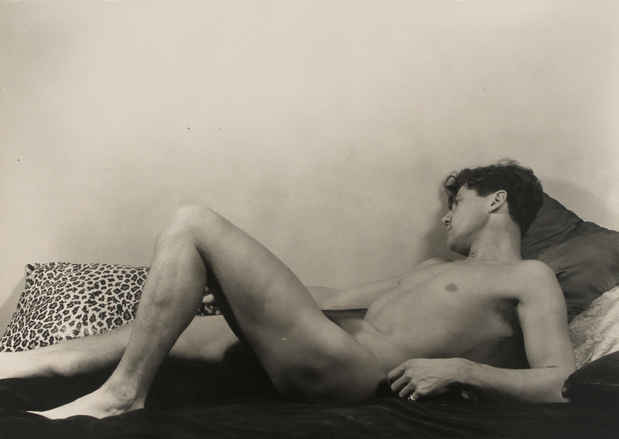George Platt Lynes, Robert Mapplethorpe, Ted Victoria Exhibitions
Robert Miller Gallery

This event has ended.
Robert Miller Gallery opens 2015 with three exhibitions, George Platt Lynes, Robert Mapplethorpe, and Ted Victoria.
George Platt Lynes includes vintage photographs of surreal mythological subjects, as well as male and female nudes by the artist.
Recognized today as a master of 20th century photography and influencing artists such as Robert Mapplethorpe and Herb Ritts, George Platt Lynes (1907 – 1955) was commercially successful in New York fashion and portrait photography. His separate art practice is largely characterized today by his remarkable photographs of nude men from the 1930s until his death. Using inventive lighting, posing, and cropping techniques within his carefully staged studio settings, he was able to translate visually both the physical and psychological nuances of his subjects.
After spending time in Paris, he entered Yale University in 1926. He left after his first semester and moved to New York City where he found his aesthetic through photography. He first photographed informal portraits in the late 1920s, then evolved to official society photography that contributed to high profile fashion magazines, solo exhibitions and significant museum shows,. His glamorous portraits of literary, film, and art world personalities suggest the type of personal relationships he had with the cognoscenti. His friendship with New York art dealer Julien Levy led to his first exhibition in 1932.
Assuming the role as head of Vogue magazine’s West Coast studio in Los Angeles in 1946, Lynes photographed celebrities like Katharine Hepburn, Rosalind Russell, Gloria Swanson, and Orson Welles. He returned to New York in 1948, focusing his photography practice on his private interests: male nudes, and the documentation of productions by the New York City Ballet. During this time, Lynes also became acquainted with Dr. Alfred Kinsey, an influential researcher on human sexuality who in 1947 founded the Institute for Sex Research at Indiana University, now known as the Kinsey Institute for Research in Sex, Gender, and Reproduction. A substantial body of Lynes’ nude and homoerotic works was ultimately left to the Kinsey Institute after Lynes’ death in 1955.
Robert Mapplethorpe comprises a selection of dye transfer and gelatin silver prints of the artist’s key subjects, including images of classical antiquity, nudes, self-portraiture and flowers.
Initially experimenting with various materials in mixed-media collages, Mapplethorpe increasingly focused his artistic practice on Polaroid photography and mounted his first solo gallery exhibition, Polaroids, in 1973 at the Light Gallery in New York City. Two years later, he turned to a Hasselblad medium-format camera and began shooting his circle of friends and acquaintances—artists, musicians, socialites, pornographic film stars, and members of the S & M underground in New York City. The resulting photographs are shocking for their content and remarkable for their technical and formal mastery. In 1977, he participated in Documenta 6 in Kassel, West Germany, and in 1978, Robert Miller Gallery became his exclusive dealer. X Portfolio, published by Robert Miller Gallery in 1978, gave exposure to some of Mapplethorpe’s most controversial images. During the 80s, Mapplethorpe produced a series of photographs that simultaneously challenge and adhere to classical aesthetic standards: stylized compositions of male and female nudes, delicate flower still lifes, and studio portraits of artists and celebrities. He also introduced and refined different techniques and formats, including color 20” x 24” Polaroids, photogravures, platinum prints on paper and linen, Cibachrome and dye transfer color prints.
His vast, provocative, and powerful body of work has established him as one of the most important artists of the twentieth century. In 1988, he established the Robert Mapplethorpe Foundation to promote photography, to support museums that exhibit photographic art, and to fund medical research in the fight against AIDS and HIV-related infection.
Robert Mapplethorpe was born in 1946 in Floral Park, Queens and received a B.F.A. from the Pratt Institute in Brooklyn. He died in 1989. Mapplethorpe’s work is represented in the collections of The Art Institute of Chicago; Corcoran Gallery of Art, Washington, DC; Solomon R. Guggenheim Museum, Metropolitan Museum of Art; Museum of Modern Art; Centre Pompidou, Paris; San Francisco Museum of Modern Art; Tate Modern, London; Whitney Museum of American Art, and many others.
“I still consider myself a painter, but now I use light instead of pigment to make the real unreal.”
– Ted Victoria
Ted Victoria comprises light projections and mixed media works, each employing the camera obscura.
Rejecting the high-tech digital formats that have become commonplace in contemporary art, Ted Victoria’s work uses lenses and mirrors to create images that challenge the viewer’s perception. The images have a diorama-like quality and create a sense of real space and movement within the confinements of a box. The images are, in fact, reflections of objects projected onto glass. The objects are thoughtfully incorporated into a work based on their functionality and reflective qualities.
Victoria expands his process further by projecting the reflection of the resulting mirrored images of the incased objects onto the gallery wall. By magnifying the common, seemingly mundane objects, viewers discover details that may otherwise be overlooked by the naked eye. Krill (2009), one of the two projections on view, augments the appearance of brine shrimp (commonly known as sea monkeys). Once magnified, these miniature crustaceans appear alien-like, swarming within a glass habitat. The second projection places incandescent and tungsten filament light bulbs side by side. The work’s title Male and Female (2012) reinforces the figurative nature of these objects as they share a place on the wall – closely but never touching.
Ted Victoria (b. 1944) received a M.F.A. from Rutgers University in 1970. His work is represented in the collections of Fonds National d’Art Contemporain, France; Indianapolis Museum of Art; the Forbes Collection, New York; Museum of Fine Arts, Dallas; Museo Tamayo, Mexico City; National Gallery of Canada, Ottawa; Tasa Collection, Munich; and many others.
Media
Schedule
from January 15, 2015 to February 21, 2015
Opening Reception on 2015-01-15 from 18:00 to 20:00